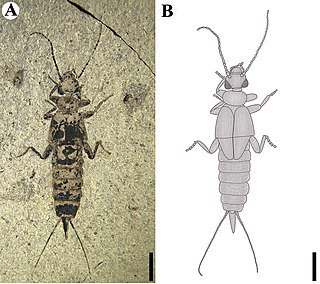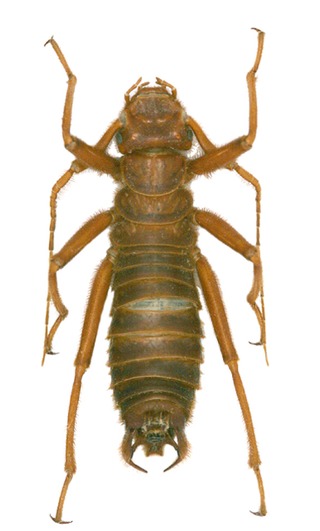
Earwigs make up the insect order Dermaptera. With about 2,000 species in 12 families, they are one of the smaller insect orders. Earwigs have characteristic cerci, a pair of forcep-like pincers on their abdomen, and membranous wings folded underneath short, rarely used forewings, hence the scientific order name, "skin wings". Some groups are tiny parasites on mammals and lack the typical pincers. Earwigs are found on all continents except Antarctica.

Forficula auricularia, the common earwig or European earwig, is an omnivorous insect in the family Forficulidae. The European earwig survives in a variety of environments and is a common household insect in North America. The name earwig comes from the appearance of the hindwings, which are unique and distinctive among insects, and resemble a human ear when unfolded; the species name of the common earwig, auricularia, is a specific reference to this feature. They are considered a household pest because of their tendency to invade crevices in homes and consume pantry foods, and may act either as a pest or as a beneficial species depending on the circumstances.

Cerci are paired appendages on the rear-most segments of many arthropods, including insects and symphylans. Many forms of cerci serve as sensory organs, but some serve as pinching weapons or as organs of copulation. In many insects, they simply may be functionless vestigial structures.

Forficulidae is a family of earwigs in the order Dermaptera. There are more than 70 genera and 490 described species in Forficulidae.

Labidura riparia is a species of earwig in the family Labiduridae characterized by their modified cerci as forceps, and light tan color. They are commonly known as the shore earwig, tawny earwig, riparian earwig, or the striped earwig due to two dark longitudinal stripes down the length of the pronotum. They are sometimes wrongly referred to as Labidura japonica, although said species is actually a subspecies, Labidura riparia japonica, found only in Japan. L. riparia are a cosmopolitan species primarily in tropical to subtropical regions. Body size varies greatly, ranging from 16 mm to 30 mm, with 10 abdominal segments. Males and females differ in forcep size, with males having much larger and stronger curve, while females have smaller, straighter forceps with a slight curve at the end. Earwigs use these forceps to assist in predation, defense, sexual selection, courting and mating, and wing folding.

Archidermaptera is an extinct suborder of earwigs in the order Dermaptera. It is one of two extinct suborders of earwigs, and contains two families known only from Late Triassic to Early Cretaceous fossils. The suborder is classified on the basis of general similarities. The Archidermaptera share with modern earwigs tegmenized forewings, though they lack the distinctive forceps-like cerci of modern earwigs, have external ovipositors, and possess ocelli. The grouping has been suggested to be paraphyletic.

Arixeniidae is a family of earwigs in the suborder Neodermaptera. Arixeniidae was formerly considered a suborder, Arixeniina, but was reduced in rank to family and included in the new suborder Neodermaptera.

Arixenia esau is a species of earwig in the genus Arixenia. It is in the family Arixeniidae, a group composed solely of ectoparasitic earwigs. Like most other species in Arixeniidae, A. esau is found in the tropics of Indonesia and Malaysia and has only been collected on the island of Borneo. The species is heavily associated with its host the hairless bat and is most commonly collected from the fur of these bats and from caves inhabited by them. Arixenia esau is a rare species and has only been observed infrequently in its natural habitat.

Hemimeridae is a family of earwigs in the suborder Neodermaptera. Hemimeridae was formerly considered a suborder, Hemimerina, but was reduced in rank to family and included in the new suborder Neodermaptera.
Archidermapteron martynovi is an extinct species of earwig, in the genus Archidermapteron, family Protodiplatyidae, the suborder Archidermaptera, the order Dermaptera, and is the only species in the genus Archidermapteron, which simply means "ancient member of the Dermaptera". It had long, segmented cerci unlike modern species of Dermaptera, but tegmina and hind wings that folded up into a "wing package" that are like modern earwigs. The only clear fossil of the species was found in Russia.
Asiodiplatys is a monotypic genus containing the single species Asiodiplatys speciousus, an extinct species of earwig in the family Protodiplatyidae. It had long and thin cerci that were very different from modern species of Dermaptera, but tegmina and hind wings that folded up into a "wing package" that are like modern earwigs. Like Archidermapteron martynovi, the only clear fossil of the species was found in Russia.

Labiduridae, whose members are known commonly as striped earwigs, is a relatively large family of earwigs in the suborder Forficulina.

The ringlegged earwig is a species of earwig in the family Anisolabididae.

Chelisoches morio, also known as the black earwig, are part of the family Chelisochidae. It is an omnivore that can be found worldwide, however it is most prominent in tropical areas, Pacific islands, the Pacific Northwest, and damp environments. The adults are jet black and can range in size from 18 to 25mm in size, though some have grown to be 36mm. The males cerci are widely separated and serrated compared to the female. The forceps are used for prey capture, defense, fighting and courtship.

Astreptolabis is an extinct genus of earwig in the Dermaptera family Pygidicranidae known from a group of Cretaceous fossils found in Myanmar. The genus contains two described species, Astreptolabis ethirosomatia and Astreptolabis laevis and is the sole member of the subfamily Astreptolabidinae.

Tytthodiplatys is an extinct genus of earwig in the family Diplatyidae known from a Cretaceous fossil found in Myanmar. The genus contains a single described species, Tytthodiplatys mecynocercus.
Zigrasolabis is an extinct genus of earwig in the family Labiduridae known from Cretaceous fossils found in Myanmar. The genus contains a single described species, Zigrasolabis speciosa.
Toxolabis is an extinct genus of earwig in the dermapteran family Anisolabididae known from a Cretaceous fossil found in Burma. The genus contains a single described species, Toxolabis zigrasi.

Neodermaptera, sometimes called Catadermaptera, is a suborder of earwigs in the order Dermaptera. There are more than 2,000 described species in Neodermaptera.

Anechurinae is a subfamily of earwigs in the family Forficulidae. There are about 9 genera and more than 70 described species in Anechurinae.















